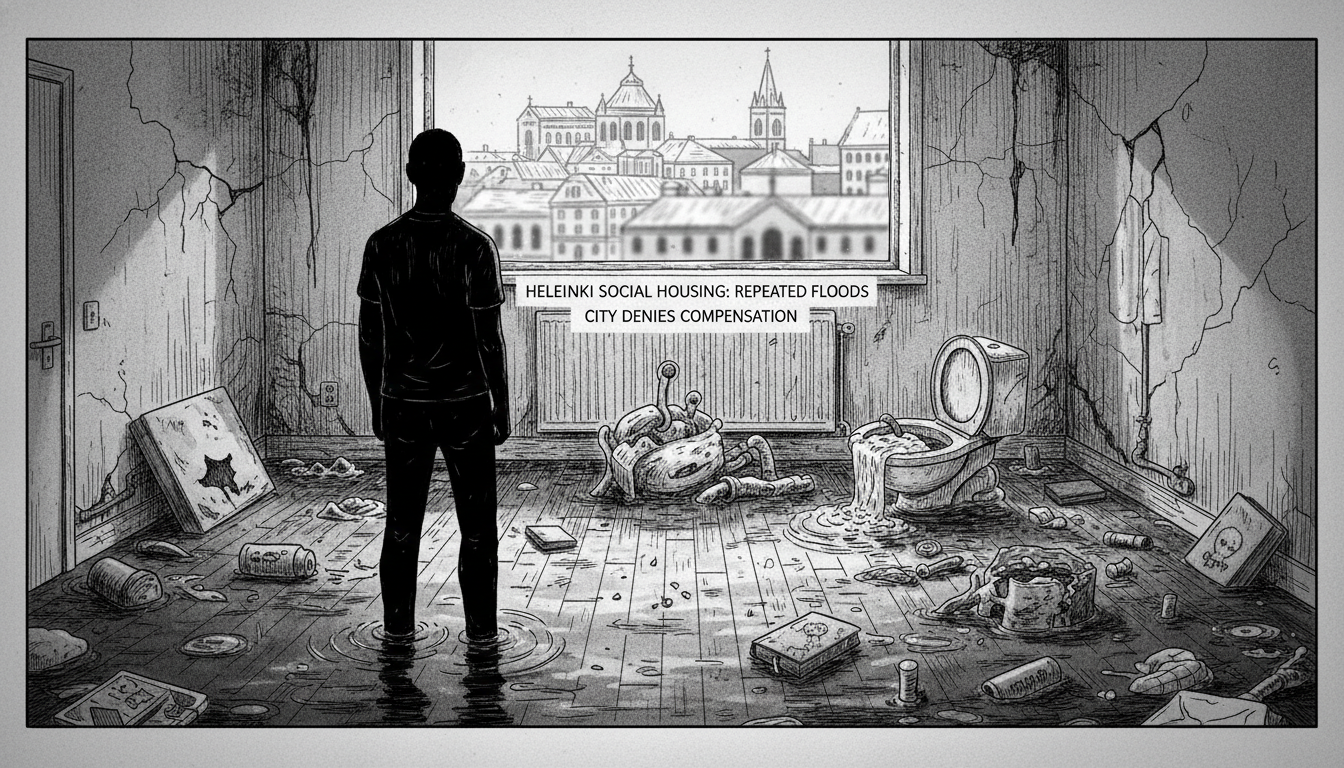Residents of a Helsinki social housing complex face their fourth sewage flood in two years, with yellow wastewater destroying personal belongings and creating health hazards. The city-owned Heka apartment building in Pasila's Postipuisto neighborhood has experienced repeated basement flooding from contaminated water, leaving tenants frustrated and demanding accountability. This situation highlights systemic maintenance challenges in Finland's public housing sector and raises questions about municipal responsibility for infrastructure failures.
Anna Seitsara, a resident who has endured all four flooding incidents, describes the basement storage areas filling with foul-smelling yellow water containing visible toilet paper residue. The most severe damage occurred in January when extensive personal property stored in basement lockers was destroyed by the contaminated floodwaters. City authorities directed affected residents to file claims with their private insurance companies rather than offering municipal compensation for the damages. This approach has left many tenants questioning the city's commitment to maintaining safe living conditions in publicly owned housing.
Heka property management director Pekka Pirinen acknowledged the recurring problem in an official statement. He identified the primary cause as clothing and diapers improperly flushed down toilets, which clogged the sewage system. The housing company is currently investigating whether specific characteristics of the wastewater pumping station might contribute to more frequent flooding incidents. Pirinen emphasized the need to exclude potential system defects while reaffirming plans to remind residents about proper waste disposal practices.
The flooding pattern reveals concerning infrastructure vulnerabilities in relatively new construction. The Pasila Postipuisto building represents modern Helsinki urban development, having been completed just two years ago. Despite its recent construction, the property has experienced flooding on multiple occasions, with water entering through heating room doors and reaching locker storage areas. Maintenance crews reported finding rags and underwear clogging drainage pipes during previous incidents, pointing to both user error and potential design flaws.
Finland's social housing system, operated primarily through municipal companies like Heka, typically maintains high standards for tenant comfort and building quality. This repeated flooding represents an unusual failure in the country's renowned public housing model. The situation has practical implications for Helsinki's growing rental sector, where municipal companies manage approximately 60,000 apartments serving diverse resident populations.
Following the most recent November incident, residents have implemented makeshift protective measures. Seitsara has moved valuable items from floor-level storage to shelves and brought some possessions into her one-bedroom apartment. The housing company now requires tenants to leave storage lockers unlocked for disinfectant spraying, though residents report inconsistent cleaning implementation. The basement maintains an unpleasant, musty odor long after cleanup operations conclude.
This pattern of infrastructure failure raises broader questions about maintenance protocols in municipal housing. While Finnish cities generally excel at property management, the repeated flooding in Pasila suggests potential gaps in preventive maintenance and emergency response systems. The incident demonstrates how relatively minor drainage issues can escalate into major property damage and tenant distress when not promptly addressed.
The financial burden has shifted entirely to residents through their private insurance policies. This approach contrasts with typical Finnish housing practices where property owners bear responsibility for building system failures. The situation has left tenants like Seitsara considering relocation despite the challenges of Helsinki's competitive rental market. The loss of trust in municipal housing management represents a significant consequence beyond the immediate property damage.
Helsinki's urban development department faces increasing scrutiny regarding building quality controls in rapidly expanding neighborhoods like Pasila. As the city continues ambitious construction projects to address housing shortages, ensuring durable infrastructure becomes increasingly important. The repeated flooding incidents serve as a cautionary example of how maintenance oversight can undermine otherwise successful urban planning initiatives.
What measures will prevent future sewage flooding in public housing? The answer likely requires both improved resident education about waste disposal and potential infrastructure modifications. Heka's investigation into the pumping station's characteristics may identify technical solutions, while clearer communication about proper toilet use could reduce clogging incidents. The situation demonstrates how urban housing management must address both human behavior and physical systems to ensure resident satisfaction and property protection.

